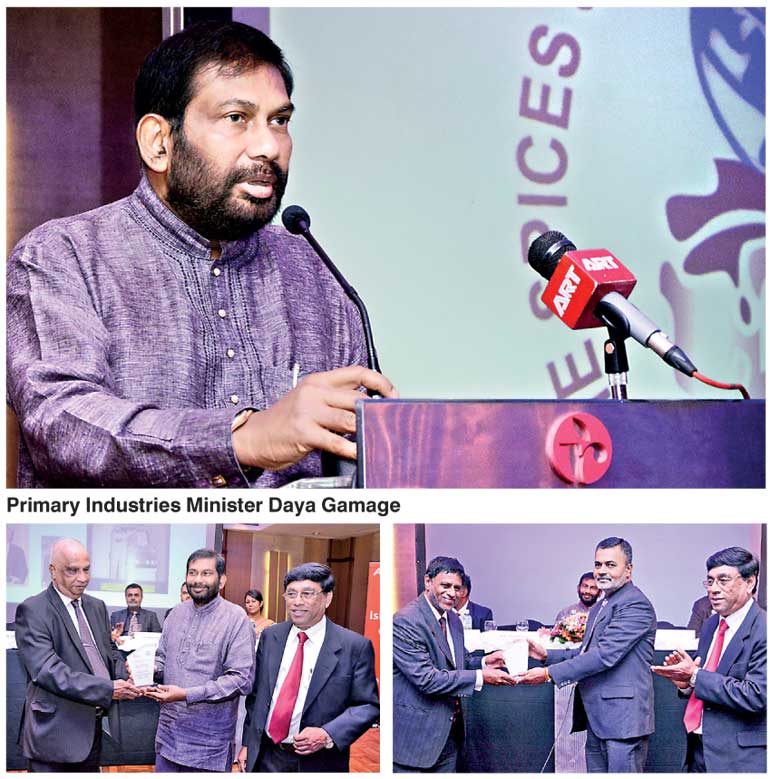Wednesday Nov 26, 2025
Wednesday Nov 26, 2025
Tuesday, 23 August 2016 00:01 - - {{hitsCtrl.values.hits}}

By Charumini de Silva
With the Government setting a target of achieving $1 billion in foreign exchange from spices and allied products by 2020, the industry now needs to aggressively look at creating a brand for Sri Lanka spices along with the support of the state organisations and private sector collaborations, a top minister said.
Noting that industries are still in bulk trading mode which needs to be shifted soon to a value based export segment, Primary Industries Minister Daya Gamage insisted on creating a brand for spices focusing on their medicinal properties to gain competitive advantage in the global market.
“We need to sell the medicinal value of our spices,” he told attendees at the 32nd Annual General Meeting (AGM) of the Spice and Allied Products Producers’ and Traders’ Association (SAPPTA) held on Friday (19).
Although it was noted that increasing production was important, the Minister emphasised that the industry could inflate export earnings fivefold with proper value additions. “We are sending out in the bulk form and 80% of the value additions are done in those markets, (we are) losing out a huge return.”
Gamage said the World Bank has approved $108 million for the Agriculture and Primary Industries Ministries for a period of three years which can be utilised by firms in upgrading into value added processed industries.
“I have proposed a matching fund. If you can invest Rs.50 million, I can grant another Rs.50 million while arranging an additional bank facility of Rs.50 million or Rs.100 million depending on the viability of the project to advance into value added processed industries,” he stated.
Outlining that the Primary Industries Ministry has already initiated several projects to increase production and value addition he admitted the execution was challenging and called for industry stakeholders to input their expertise to fortify these projects.
The Minister said he had advised Development Officers engaged in 329 Provincial Councils to deploy 10 projects in each village totalling to 3,290 projects that would help boost the production. In addition the ministry has initiated a program focused on one million women for home gardening for the export market as well.
“Of the total land 23% is home gardens and if we can cultivate crops that can be exported, it has the potential to increase our exports to gross domestic product (GDP) by 2%. Despite the opportunity only 20% would actually invest in this, I need the support of the industries to push the balance 80%. Already we have allocated Rs.125 million to provide plants,” he opined.
Gamage reiterated that the Government’s objective is to develop the industry alongside the companies and farmers returns.
Citing that the Government is in the process of converting non-strategic developments made during the previous regime, he urged the local industries to seize the opportunities opening up before they are all taken up by foreign companies.
Responding to a request made by the Association the Minister promised to provide funds to set up a few sterilisation units to facilitate the spice industry. However, he refused to provide free plants to companies existing in the business and recommended firms to invest in plants while assuring that the technical assistance to increase their production would be provided from the State institutes.
The apex industry body for spices, calls for the removal of the 2,500 tons cap imposed by the Government of India citing that it has been unfair by the Sri Lankan exporters despite having the Indo-Lanka free trade agreement (FTA) and several representations made by the Government of Sri Lanka.
With the Government of Sri Lanka looking at signing a fresh trade agreement with India, Spices and Allied Products Producers’ and Traders Association (SAPPTA) is hopeful that this non-tariff barrier would be removed.
“While our request is to remove the cap on spices, we learn that the two Governments are in the offing to sign the Economic and Technology Cooperative Agreement (ETCA). We urge the Government to lobby once again to do away with the limitation imposed by India to allow free trade,” SAPPTA Chairman Vernon Abeyratne who was re-elected again at the 32nd Annual General Meeting (AGM) of the Association held last week.
The Certificate of Origin issued by the Industry and Commerce Ministry allows licence holders in Sri Lanka to export spices to India 100% duty free, however due to the 2,500 tons restriction imposed by the Government of India the potential of the exports has been tapered.
 SAPPTA Chairman Vernon Abeyratne addressing the AGM
SAPPTA Chairman Vernon Abeyratne addressing the AGM
Noting that marketing spices is not a major problem, he said the need of the hour was to increase the yield per acre production which would lead to increased exports.
In addition he stated it was important to offer quality spices and called for the assistance of the Sri Lanka Standards Institute (SLSI).
Pointing out that Sri Lanka accounts for 10% of the world’s spice production he elaborated that if the industry is to increase exports keeping in line with the Government’s policy, efforts have to be made in making the landscape increasingly productive for farmers and firms.
Abeyratne commended the Government’s decision to do away with the export cess on spices in November last year adding that it had helped spices to be more competitive in the world market. “Exporters are today in a position to offer higher prices to the farmers, pepper prices have increased to Rs.1,350 per kilo, while cinnamon is getting Rs.450 to Rs.2,000 per kilo according to the grades.”